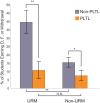Peer-Led Team Learning Helps Minority Students Succeed
- PMID: 26959826
- PMCID: PMC4784972
- DOI: 10.1371/journal.pbio.1002398
Peer-Led Team Learning Helps Minority Students Succeed
Abstract
Active learning methods have been shown to be superior to traditional lecture in terms of student achievement, and our findings on the use of Peer-Led Team Learning (PLTL) concur. Students in our introductory biology course performed significantly better if they engaged in PLTL. There was also a drastic reduction in the failure rate for underrepresented minority (URM) students with PLTL, which further resulted in closing the achievement gap between URM and non-URM students. With such compelling findings, we strongly encourage the adoption of Peer-Led Team Learning in undergraduate Science, Technology, Engineering, and Mathematics (STEM) courses.
Conflict of interest statement
The authors have declared that no competing interests exist.
Figures


References
-
- Freeman S, Eddy S, McDonough M, Smith M, Okoroafor N, Jordt H, et al. Active learning increases student performance in science, engineering, and mathematics. Proc Natl Acad Sci U S A. 2014;111(23): 8410–8415. doi: 10.1073/pnas.1319030111 - DOI - PMC - PubMed
-
- Roth V, Goldstein E, Marcus G. Peer-Led Team Learning: A Handbook for Leaders, Upper Saddle River, NJ: Prentice Hall; 2001.
-
- Woodward A, Gosser DK, Weiner M. Problem solving workshops in general chemistry. J Chem Educ. 1993;70: 651–652.
-
- Gosser DK, Roth V, Gafney L, Kampmeier J, Strozak V, Varma-Nelson P, et al. Workshop chemistry: Overcoming the barriers to student success. The Chem Educ. 1996;1: 1–17.
Publication types
MeSH terms
LinkOut - more resources
Full Text Sources
Other Literature Sources
Miscellaneous

